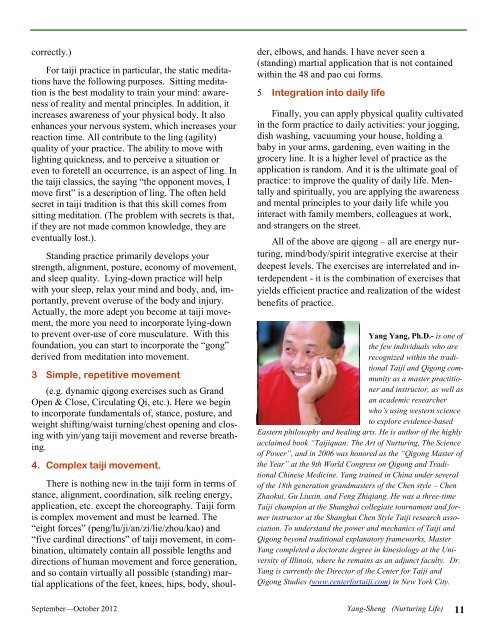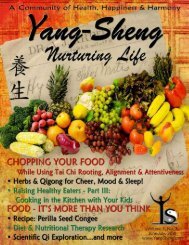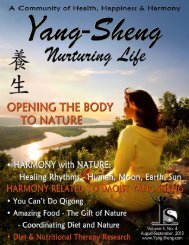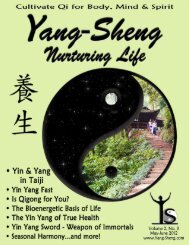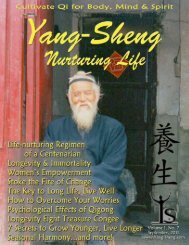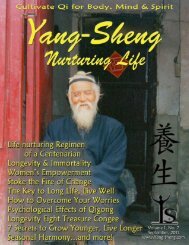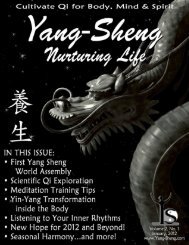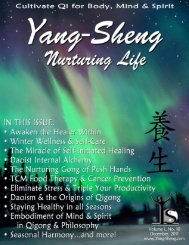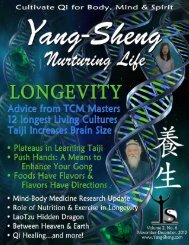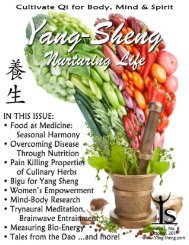Download - Yang-Sheng
Download - Yang-Sheng
Download - Yang-Sheng
You also want an ePaper? Increase the reach of your titles
YUMPU automatically turns print PDFs into web optimized ePapers that Google loves.
correctly.)<br />
For taiji practice in particular, the static meditations<br />
have the following purposes. Sitting meditation<br />
is the best modality to train your mind: awareness<br />
of reality and mental principles. In addition, it<br />
increases awareness of your physical body. It also<br />
enhances your nervous system, which increases your<br />
reaction time. All contribute to the ling (agility)<br />
quality of your practice. The ability to move with<br />
lighting quickness, and to perceive a situation or<br />
even to foretell an occurrence, is an aspect of ling. In<br />
the taiji classics, the saying “the opponent moves, I<br />
move first” is a description of ling. The often held<br />
secret in taiji tradition is that this skill comes from<br />
sitting meditation. (The problem with secrets is that,<br />
if they are not made common knowledge, they are<br />
eventually lost.).<br />
Standing practice primarily develops your<br />
strength, alignment, posture, economy of movement,<br />
and sleep quality. Lying-down practice will help<br />
with your sleep, relax your mind and body, and, importantly,<br />
prevent overuse of the body and injury.<br />
Actually, the more adept you become at taiji movement,<br />
the more you need to incorporate lying-down<br />
to prevent over-use of core musculature. With this<br />
foundation, you can start to incorporate the “gong”<br />
derived from meditation into movement.<br />
3 Simple, repetitive movement<br />
(e.g. dynamic qigong exercises such as Grand<br />
Open & Close, Circulating Qi, etc.). Here we begin<br />
to incorporate fundamentals of, stance, posture, and<br />
weight shifting/waist turning/chest opening and closing<br />
with yin/yang taiji movement and reverse breathing.<br />
4. Complex taiji movement.<br />
There is nothing new in the taiji form in terms of<br />
stance, alignment, coordination, silk reeling energy,<br />
application, etc. except the choreography. Taiji form<br />
is complex movement and must be learned. The<br />
“eight forces” (peng/lu/ji/an/zi/lie/zhou/kao) and<br />
“five cardinal directions” of taiji movement, in combination,<br />
ultimately contain all possible lengths and<br />
directions of human movement and force generation,<br />
and so contain virtually all possible (standing) martial<br />
applications of the feet, knees, hips, body, shoulder,<br />
elbows, and hands. I have never seen a<br />
(standing) martial application that is not contained<br />
within the 48 and pao cui forms.<br />
5 Integration into daily life<br />
Finally, you can apply physical quality cultivated<br />
in the form practice to daily activities: your jogging,<br />
dish washing, vacuuming your house, holding a<br />
baby in your arms, gardening, even waiting in the<br />
grocery line. It is a higher level of practice as the<br />
application is random. And it is the ultimate goal of<br />
practice: to improve the quality of daily life. Mentally<br />
and spiritually, you are applying the awareness<br />
and mental principles to your daily life while you<br />
interact with family members, colleagues at work,<br />
and strangers on the street.<br />
All of the above are qigong – all are energy nurturing,<br />
mind/body/spirit integrative exercise at their<br />
deepest levels. The exercises are interrelated and interdependent<br />
- it is the combination of exercises that<br />
yields efficient practice and realization of the widest<br />
benefits of practice.<br />
<strong>Yang</strong> <strong>Yang</strong>, Ph.D.- is one of<br />
the few individuals who are<br />
recognized within the traditional<br />
Taiji and Qigong community<br />
as a master practitioner<br />
and instructor, as well as<br />
an academic researcher<br />
who’s using western science<br />
to explore evidence-based<br />
Eastern philosophy and healing arts. He is author of the highly<br />
acclaimed book “Taijiquan: The Art of Nurturing, The Science<br />
of Power”, and in 2006 was honored as the “Qigong Master of<br />
the Year” at the 9th World Congress on Qigong and Traditional<br />
Chinese Medicine. <strong>Yang</strong> trained in China under several<br />
of the 18th generation grandmasters of the Chen style – Chen<br />
Zhaokui, Gu Liuxin, and Feng Zhiqiang. He was a three-time<br />
Taiji champion at the Shanghai collegiate tournament and former<br />
instructor at the Shanghai Chen Style Taiji research association.<br />
To understand the power and mechanics of Taiji and<br />
Qigong beyond traditional explanatory frameworks, Master<br />
<strong>Yang</strong> completed a doctorate degree in kinesiology at the University<br />
of Illinois, where he remains as an adjunct faculty. Dr.<br />
<strong>Yang</strong> is currently the Director of the Center for Taiji and<br />
Qigong Studies (www.centerfortaiji.com) in New York City.<br />
September—October 2012 <strong>Yang</strong>-<strong>Sheng</strong> (Nurturing Life) 11


